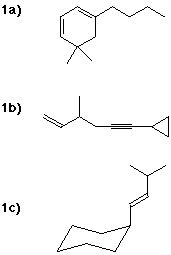
Chemistry 331 - Winter 1996
Elements of Organic Chemistry I

Homework, Chapter 4 - Alkenes and Alkynes
McMurry, pp 137 - 140:
Problems 4.25-31, 33, 34, 36, 39, 40, 41, 43, 44, 45, 46, 47, 53, 54, 55
1. Write IUPAC names, including designation of stereochemistry where needed,
for each of the following compounds:

2. When chlorine is added to an alkene in aqueous (water) solution, another
major product besides the dichloro addition product is usually observed.
For example, propene reacts with aqueous chlorine to form 1-chloro-2-propanol
as the major product.
Write a mechanism that explains how this product forms.
Indicate how formation of this product relates to the Markovnikov rule.
3. Many alkenes undergo polymerization not only by free radical polymerization,
but also by cationic polymerization. During World War 2, as a substitute
for natural rubber, butyl rubber was made by cationic polymerization of
isobutylene (2-methylpropene).
Write a chain reaction mechanism for cationic polymerization of isobutylene,
using strong acid (H+) as initiator.
Explain why isobutylene would be particularly favorable for this type of
reaction.
